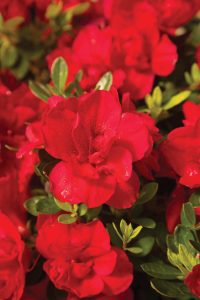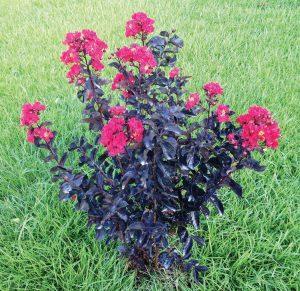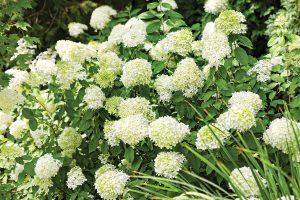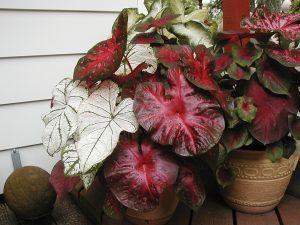Colorful plants are a beautiful way to brighten your landscape, add interest to your yard, and make your home feel more inviting. However, it can be a pain to plant and replant with each season. Planting new plants every few months can be expensive and time-consuming. Try planting these plants for long-lasting color in your yard with little hassle.
 For vibrant color throughout all four seasons, try Autumn Fire Azaleas. This reblooming azalea produces 2.5 inch true red blooms in spring, summer, and fall. During the winter, the glossy, green foliage intensifies into a gorgeous purple bronze color, providing interest during periods without blooms. These azaleas like more sun than traditional azaleas and perform best in four to six hours of direct sun. Plant your Autumn Fire Azaleas in slightly acidic, rich, well-drained soil, with the root ball an inch or two above the soil level. During the first year after planting, ensure that your azaleas are not allowed to dry out completely. A layer of pine straw, mulch, or compost will help protect the roots and inhibit weed growth. After the threat of frost has passed in the spring, and again in August, fertilize with a well-rounded, slightly acidic azalea fertilizer. Pruning should be done immediately after the spring bloom.
For vibrant color throughout all four seasons, try Autumn Fire Azaleas. This reblooming azalea produces 2.5 inch true red blooms in spring, summer, and fall. During the winter, the glossy, green foliage intensifies into a gorgeous purple bronze color, providing interest during periods without blooms. These azaleas like more sun than traditional azaleas and perform best in four to six hours of direct sun. Plant your Autumn Fire Azaleas in slightly acidic, rich, well-drained soil, with the root ball an inch or two above the soil level. During the first year after planting, ensure that your azaleas are not allowed to dry out completely. A layer of pine straw, mulch, or compost will help protect the roots and inhibit weed growth. After the threat of frost has passed in the spring, and again in August, fertilize with a well-rounded, slightly acidic azalea fertilizer. Pruning should be done immediately after the spring bloom.
 Similarly, Black Diamond Crape Myrtles provide a unique beauty to your landscape from early spring until late fall or early winter. Black foliage emerges in early spring and is followed by large clusters of vibrant jewel-toned blossoms that last until the first frost. Black Diamond crape myrtles have a naturally compact habit and max out at a size of ten to twelve feet in height and eight feet in width. They can be used in groups to create a beautiful flowering hedge, planted in pots to place on your deck or porch, or used as a specimen plant within the garden. Once established, these gorgeous shrubs or small trees are extremely low maintenance and drought tolerant, providing interest in the garden from spring through fall. You can expect instantaneous yard envy from your neighbors after planting a few of these unique crape myrtles.
Similarly, Black Diamond Crape Myrtles provide a unique beauty to your landscape from early spring until late fall or early winter. Black foliage emerges in early spring and is followed by large clusters of vibrant jewel-toned blossoms that last until the first frost. Black Diamond crape myrtles have a naturally compact habit and max out at a size of ten to twelve feet in height and eight feet in width. They can be used in groups to create a beautiful flowering hedge, planted in pots to place on your deck or porch, or used as a specimen plant within the garden. Once established, these gorgeous shrubs or small trees are extremely low maintenance and drought tolerant, providing interest in the garden from spring through fall. You can expect instantaneous yard envy from your neighbors after planting a few of these unique crape myrtles.
You can also add color that will last from spring through fall with the colorful leaves of caladiums. There are many types of caladiums to choose from. For a vibrant splash of color, choose your favorite variety and plant them in mass, or try varieties with bunches of smaller leaves in pots and window boxes. Caladiums are excellent companions for impatiens, begonias, and ferns; they really liven up a shady garden bed! While most caladiums require shade, some are tolerant of full sun; these varieties tend to require more watering. Too much sun exposure can result in holes with brown edges on the leaves, but, fortunately, caladiums are easy to dig up and relocate when needed! If starting with bulbs, choose the largest bulbs you can find because larger bulbs contain more stored energy and will produce more foliage. Plant in well-drained soil that is rich in organic material, and keep the soil slightly moist. Add mulch to help retain soil moisture, and use a slow release fertilizer. You may need to dig up caladiums in the fall if you wish to re-plant them the next year.
 For colorful interest from summer through winter, try incorporating Limelight Hydrangeas into your landscape. They produce unique chartreuse blooms in the summer which then turn creamy white, and, finally, deep rose by autumn. Limelight is prized for its large, panicle-shaped flowers, which can grow six to twelve inches long. This deciduous shrub grows up to eight feet tall and just as wide, is hardy to zone three, and is fairly drought tolerant. Plant your Limelight Hydrangeas in partial shade or bright, full sun in good loamy soil. Unlike other hydrangeas, soil pH does not affect the color of the blooms, although the color of the blooms does change with time. You may plant this hydrangea in groupings, as a specimen, or even in a container. Unlike Mophead and Lacecap Hydrangeas, which bloom on old wood from the previous year, Limelight Hydrangeas bloom on new growth. They should be pruned in late winter before the new stems appear in order to avoid removing future buds.
For colorful interest from summer through winter, try incorporating Limelight Hydrangeas into your landscape. They produce unique chartreuse blooms in the summer which then turn creamy white, and, finally, deep rose by autumn. Limelight is prized for its large, panicle-shaped flowers, which can grow six to twelve inches long. This deciduous shrub grows up to eight feet tall and just as wide, is hardy to zone three, and is fairly drought tolerant. Plant your Limelight Hydrangeas in partial shade or bright, full sun in good loamy soil. Unlike other hydrangeas, soil pH does not affect the color of the blooms, although the color of the blooms does change with time. You may plant this hydrangea in groupings, as a specimen, or even in a container. Unlike Mophead and Lacecap Hydrangeas, which bloom on old wood from the previous year, Limelight Hydrangeas bloom on new growth. They should be pruned in late winter before the new stems appear in order to avoid removing future buds.
Whether you choose to plant one, two, three, or all four of these plants, you can improve your home by adding color to your yard in this simple way. Upgrade your yard by planting plants that will add color this spring, summer, fall, and winter. You will love seeing color all year round from the plants you planted this spring. ![]()
Shannon Ruark
Esposito Garden Center





